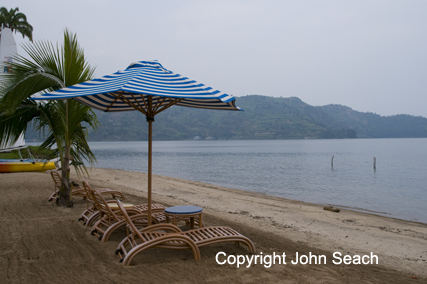Volcano Live
volcanolive.com
Lake Kivu | John Seach

Democratic Republic of Congo/ Rwanda
Lake Kivu is located on the western branch of the east African rift. Lake Kivu has an altitude of 1462m and maximum depth of 485m. The lake has a surface area of 2370 sq km and a volume of 560 cubic km.
Lake Kivu contains dissolved carbon dioxide and methane. The dissolved gases pose a significant hazard for people living around its shores.

Lake Kivu, Rwanda - John Seach
An estimated 250 cubic km (equivalent volume at 1 ATM) of dissolved carbon dioxide lies at depth. If released to the surface, this would be enough to coved the lake in a 100 m deep cloud of gas. Even a small release of CO2 could be devastating.
Methane concentrations are five times lower than carbon dioxide, but contribute 80-90% of the gas pressure due to its lower solubility. Carbon dioxide in the lake is derived from magmatic sources. Two-thirds of the methane in Lake Kivu is produced by bacterial reduction of CO2 with hydrogen.
The Virunga range lies at the northern end of the lake. Nyiragongo Volcano is the closest to Lake Kivu, but lava flows from Nyamuragira volcano further north have also flowed to into the lake.
Mechanisms of Gas Eruption at Lake Kivu
There are three mechanisms which may lead to a gas release at Lake Kivu.
1) Gas concentrations may build up at depth to cause overpressure.
2) Volcanic eruption may produce enough thermal energy to create a rising plume which would carry gas to the surface.
3) A volcanic eruption may release gas from lake sediments.
2009 Gas Hazard
Gases trapped below the surface of a lake in eastern Congo could explode any day, threatening the lives of tens of thousands of locals, the environment minister of Democratic Republic of Congo warned on Tuesday 25th August 2009. Researchers have discovered a high concentration of gas in the relatively shallow Gulf of Kabuno, in the lake's northwest corner. "The risk of explosion is imminent," Jose Endundo said. There is an estimated three cubic kilometres of carbon dioxide located 12 metres below the surface of the gulf, which sits on a tectonic fault. Scientists fear an earthquake or large lava flow from a nearby Nyiragongo or Nyamuragira volcanoes could create a release of gas, creating a deadly cloud. An eruption of some 1.2 million tonnes of CO2 that had been trapped under Lake Nyos in isolated northwestern Cameroon killed around 1,700 people in 1986. Several large villages lie on the shores of the Gulf of Kabuno, and the city of Goma, with a population of around 1 million, is located around 20 km to the east. Rwanda has already begun extracting small amounts of methane using a demonstration rig on its side of the lake. It was producing two megawatts of power by the end of 2008.
Further reading
Pasche, N., Schmid, M., Vazquez, F., Schubert, C.J., Wüest, A., Kessler, J.D., Pack, M.A., Reeburgh, W.S. and Bürgmann, H., 2011. Methane sources and sinks in Lake Kivu. Journal of Geophysical Research: Biogeosciences, 116(G3).
Schmid, M., Halbwachs, M., Wehrli, B. and Wüest, A., 2005. Weak mixing in Lake Kivu: new insights indicate increasing risk of uncontrolled gas eruption. Geochemistry, Geophysics, Geosystems, 6(7).
Degens, E.T., von Herzen, R.P., Wong, H.K., Deuser, W.G. and Jannasch, H.W., 1973. Lake Kivu: structure, chemistry and biology of an East African rift lake. Geologische Rundschau, 62(1), pp.245-277.